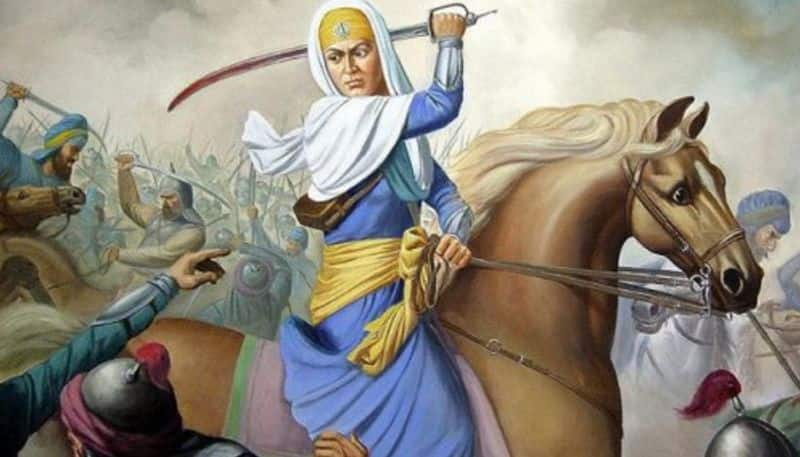Sikh history has recorded the role of women, portraying them as equals to men in service, devotion, sacrifice, and bravery. In India, women of the Sikh faith have fought, ruled, taught and served for centuries
The Sikh scriptures state that women have the same souls as men and thus possess an equal right to cultivate their spirituality, with equal chances of achieving salvation. Guru Nanak condemned the man-made notion of the inferiority of women, and protested against their long subjugation.
Guru Granth Sahib states, “From the woman is our birth, and in the woman’s womb are we shaped. To the woman we are engaged and to the woman are we wedded. The woman is our friend and from woman is the family. Through the woman are the bonds of the world. Why then call her evil, who gives birth to the world’s leaders? From the woman is born woman, without the woman there is none”.
Sikh history has recorded the role of women, portraying them as equals to men in service, devotion, sacrifice, and bravery. In India, women of the Sikh faith have fought, ruled, taught and served for centuries.
Here are 5 Sikh women in history we should know more about:
1. Gulab Kaur

Source: Wikimedia
An Indian freedom fighter, Gulab Kaur joined Ghadar Party in Manila, an organisation founded by Sikh-Punjabi immigrants with the aim to liberate the subcontinent from British Rule. Posing as a journalist with a press pass in hand, she distributed arms to the Ghadar Party members. Kaur also encouraged others to join the Ghadar Party by distributing independence literature and delivering inspiring speeches to Indian passengers of ships.She was sentenced to two years in prison in Lahore, then in British-India and now in Pakistan, for seditious acts.
2. Harita Kaur Deol

Source: beaninspirer
Flight Lt. Harita Kaur Deol was the first woman to fly solo in Indian Air Force. She became one of the first seven women cadets inducted into the Air Force as Short Service Commission (SSC) officers. This also marked a critical phase in training of women in India as transport pilots. Her first flight was on September 2 1994 in an Avro HS-748, when she was 22 years old. She died in an aircrash near Nellore on December 24, 1996, at age 24.
3. Mata Khivi

Source: Sikhnet
Mata Khivi is best known as the person who expanded the Sikh tradition of langar. She continued to help perfect the langar system until the Guruship of Guru Arjan Dev and the langar became known as "Khivi ka Langar". She is mentioned by name in the Guru Granth Sahib "Balwand says that Khivi, the Guru`s wife, is a noble woman, who gives soothing, leafy shade to all. She distributes the bounty of the Guru`s Langar; the kheer - the rice pudding and ghee, is like sweet ambrosia."
4. Sada Kaur

Source: wikimedia
Sada Kaur was the chief of the Kanhaiya Misl from 1789 to 1821. She was the wife of Gurbaksh Singh Kanhaiya, the leader of the Kanhaiya Misl. After her husband's death in 1785 and her father-in-law's death in 1789, she became the chief of the Kanhaiya Misl. She was known as a poised and strategic leader, and she joined forces with her son-in-law, Ranjit Singh, in an effort to unite Punjab into one nation-state. To achieve this, she led armies into battle and negotiated at diplomatic tables. Punjab ultimately came together under their leadership—Ranjit Singh came to be Maharaja (King), and she served as the Regent of Punjab.
5. Mai Bhago

Source: sikhiwiki
Mai Bhago, also known as Mata Bhag Kaur was a Sikh woman who led 40 Sikh soldiers against the Mughals in 1705. She killed several enemy soldiers on the battlefield and is considered to be a saint warrior by the Sikh nation for over 300 years. She was the sole survivor of the battle of Khidrana, also known as the Battle of Muktsar.
Last Updated Nov 23, 2018, 4:03 PM IST











![Salman Khan sets stage on fire for Anant Ambani, Radhika Merchant pre-wedding festivities [WATCH] ATG](https://static-ai.asianetnews.com/images/01hr1hh8y86gvb4kbqgnyhc0w0/whatsapp-image-2024-03-03-at-12-24-37-pm_100x60xt.jpg)
![Pregnant Deepika Padukone dances with Ranveer Singh at Anant Ambani, Radhika Merchant pre-wedding bash [WATCH] ATG](https://static-ai.asianetnews.com/images/01hr1ffyd3nzqzgm6ba0k87vr8/whatsapp-image-2024-03-03-at-11-45-35-am_100x60xt.jpg)



